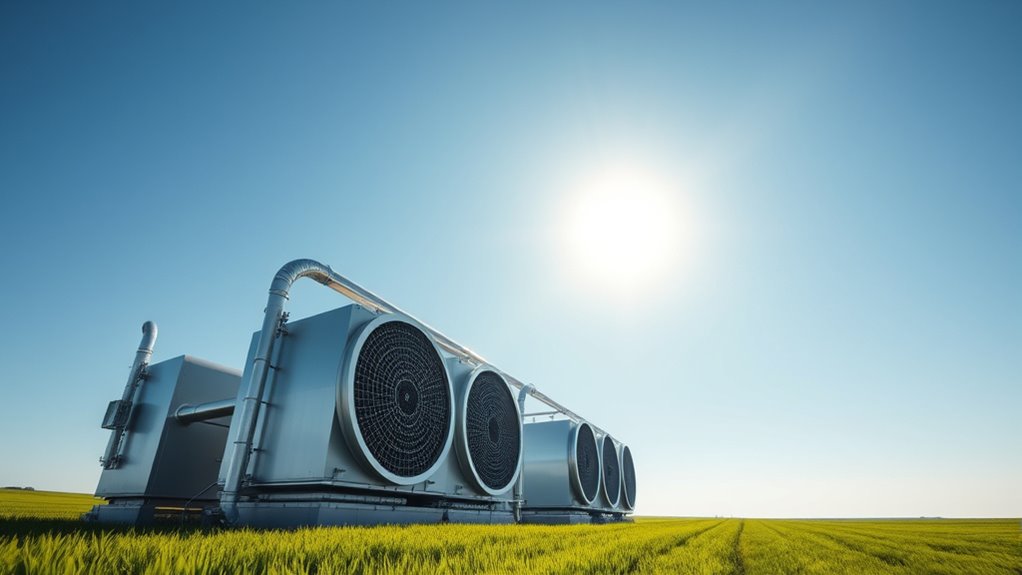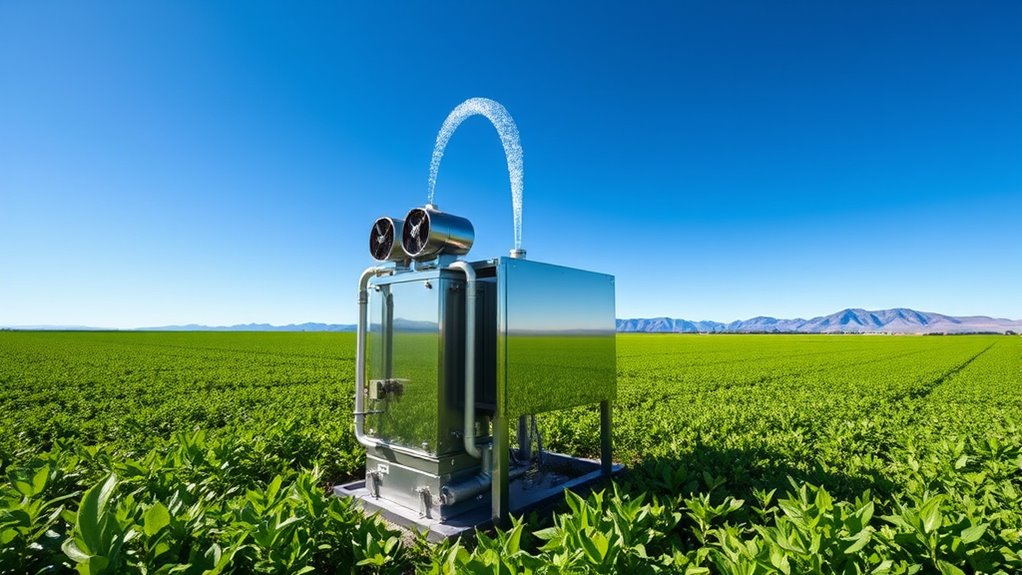Direct Air Capture (DAC) actively pulls CO₂ from the atmosphere using advanced filters or solvents, which react with the gas. Fans draw in air, and the captured CO₂ is then released by heating, allowing the sorbents to be reused. This technology helps reduce greenhouse gases and fight climate change. When powered by renewable energy, DAC becomes a sustainable solution for long-term CO₂ removal. To see how this process works and its future potential, keep exploring further.
Key Takeaways
- DAC technology captures atmospheric CO₂ directly using sorbents or solvents, reducing greenhouse gases.
- Air is drawn into DAC units by fans, where CO₂ binds to capture mediums for extraction.
- Captured CO₂ is purified and then stored permanently via geologic sequestration or utilized in products.
- Renewable energy or waste heat powers DAC systems, ensuring environmentally sustainable operation.
- DAC plays a vital role in achieving net-negative emissions and combating climate change.

Have you ever wondered how we can directly remove CO₂ from the air to combat climate change? It’s a technology called Direct Air Capture (DAC), and it’s designed to do exactly that—capture carbon dioxide straight from the atmosphere. Unlike traditional methods that target emissions at their source, such as factories or power plants, DAC pulls CO₂ out of the air itself. Its main goal is to reduce the amount of greenhouse gases floating around, helping to slow down global warming. The process relies on renewable energy sources or waste heat to power the capture units, making sure it’s environmentally friendly during operation. This approach is seen as a pivotal tool for achieving net-negative emissions, which are essential for meeting climate targets. Once captured, the CO₂ can be stored underground permanently or used in various industries. However, permanent storage offers the most significant climate benefits by preventing CO₂ from re-entering the atmosphere.
In practice, air is actively drawn into DAC units by large fans, due to the low concentration of CO₂ in the atmosphere—only about 0.04%. Inside the units, CO₂ molecules react chemically with selective filters made of sorbents or solvents that specifically bind to carbon dioxide but let other gases pass through. These capture mediums are typically liquid solvents or solid sorbents, both of which are chemicals already used in other industrial processes. After the filters become saturated with CO₂, they’re heated to around 100°C, releasing a concentrated stream of CO₂ and regenerating the sorbent or solvent for reuse. Some newer electrochemical methods are also in development, aiming to reduce energy consumption and operational costs. Research into energy-efficient methods is ongoing to improve the sustainability of DAC technology. Once separated, the CO₂ is purified through various filtration steps to remove impurities, ensuring it’s suitable for storage or utilization. This purification process increases the CO₂ concentration from atmospheric levels to over 95%, preparing it for safe handling. Monitoring systems track the entire process to optimize efficiency and prevent leaks. For permanent storage, the preferred method is geologic sequestration—injecting CO₂ deep into porous rock formations sealed by impermeable layers. In Iceland, for example, the partnership between Climeworks and Carbfix injects CO₂ into basalt formations, where it mineralizes into stable carbonates within decades, guaranteeing long-term storage. This method is considered the safest and most scalable, with storage stability lasting tens of thousands of years. Although some captured CO₂ is used to create building materials like concrete or synthetic fuels, these options generally provide shorter-term storage. Overall, DAC is a promising technology that offers a direct way to reduce atmospheric CO₂ and combat climate change.
Frequently Asked Questions
What Are the Long-Term Environmental Impacts of DAC Technology?
The long-term environmental impacts of DAC technology include potential risks to underground CO₂ storage safety, such as leaks that could undermine climate goals. You should consider the energy sources powering DAC; if they rely on fossil fuels, emissions might outweigh benefits. Additionally, large infrastructure expansion could affect communities and ecosystems. Ensuring robust monitoring, using renewable energy, and involving local communities are crucial to minimizing negative impacts over time.
How Does DAC Compare Cost-Wise to Traditional Carbon Capture Methods?
You’ll find that direct air capture currently costs much more per ton of CO₂ than traditional methods, mainly due to higher capital and operating expenses. While traditional capture is cheaper for concentrated sources, DAC’s costs are rising but expected to drop notably by 2030–35. Investing in DAC now could pay off long-term by enabling scalable, flexible carbon removal, though it still needs technological breakthroughs to become more competitive.
Can DAC Be Scaled to Meet Global Co₂ Reduction Targets?
You’re wondering if DAC can scale enough to meet global CO₂ reduction goals. While current capacity is small, rapid growth projections and significant investments show potential. You should know that DAC’s scalability depends on reducing costs, expanding infrastructure, and improving energy efficiency. Although challenges exist, ongoing technological advancements and increasing climate commitments make it possible for DAC to play a crucial role in achieving global climate targets.
What Are the Potential Uses for the Captured Co₂?
You’re wondering about the potential uses for captured CO₂. It can serve as a cleaner, onsite source of carbon for industrial processes, like producing synthetic fuels and plastics. You can also store it underground permanently or recycle it into valuable products, such as fertilizers or construction materials. When powered by renewable energy, these uses help reduce emissions and support a circular economy, making CO₂ a resource rather than waste.
How Does Weather Affect the Efficiency of DAC Systems?
Weather impacts DAC efficiency by affecting temperature, humidity, and atmospheric pressure. When it’s cool around 10°C, your system captures CO₂ most effectively, but warmer weather increases energy needs. Moderate humidity helps, yet high moisture can reduce performance. Variations in pressure and CO₂ levels also influence results. Adjusting operations based on hourly weather data can cut energy costs and improve consistency, making site climate a key factor in system success.
Conclusion
Think of direct air capture as a beacon of hope, shining a light on our path to a cleaner planet. By pulling CO₂ from the sky, you’re helping to turn the tide against climate change. Every effort counts, like drops in a vast ocean, creating waves of change. Embrace this technology; it’s your tool to rewrite the story of our future—one breath at a time, you can help restore balance to our world.










